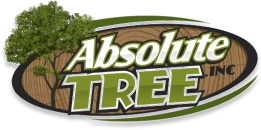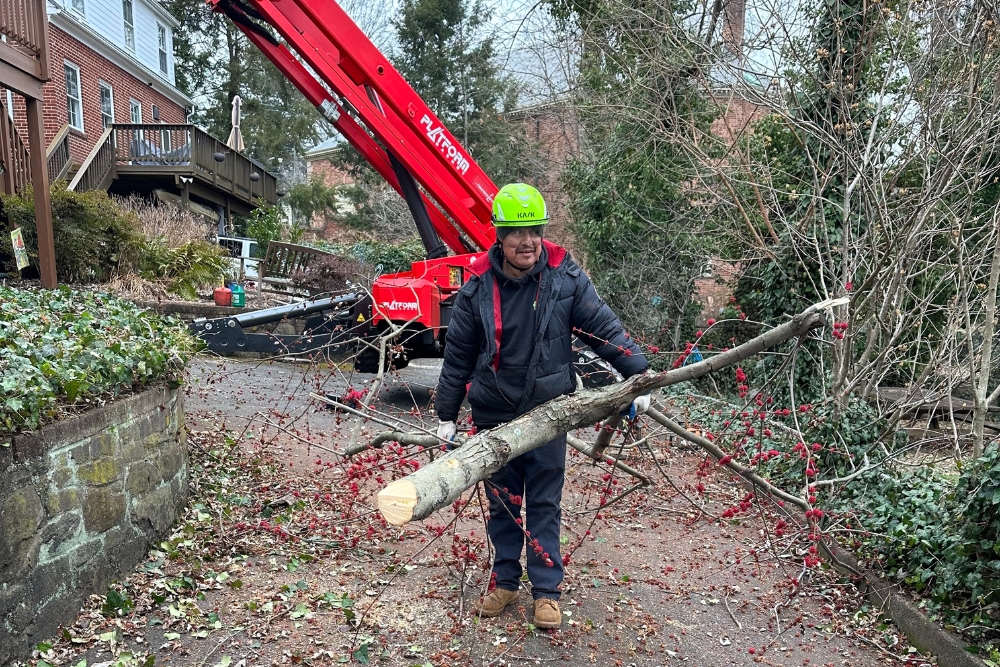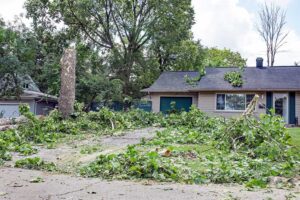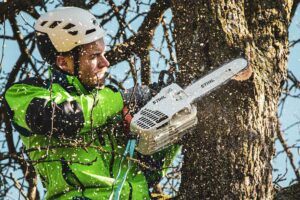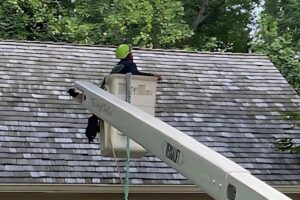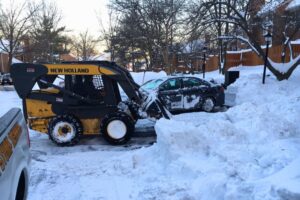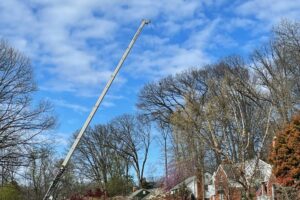Trees are an asset to your Northern Virginia property but can also pose a danger during a vicious summer storm. The combination of high winds and torrential rain can cause significant damage to your trees and sometimes your property.
In this article, we will examine the importance of pruning to avoid storm damage and what kind of pruning work we do after a storm to prevent damage from future storms. We’ll also examine storm preparation differences in urban areas (like Arlington and Alexandria) versus rural areas like Fairfax Station or Clifton.
Key Takeaways
- Northern Virginia sees frequent summer storms that cause damage from falling trees and flying branches.
- Trees can develop weaknesses that frequently break in storms, such as included bark in the branch union and co-dominant leaders that compete to be the center point of the tree.
- Pruning mature trees should focus on removing weak, overextended, or damaged branches before or after a storm to limit the risk of future storm damage.
- Pruning young trees should work to encourage proper growth and avoid competing branches.
- Pruning to prevent storm damage is more important in urban areas where houses and trees are close together, and damage is more common; rural residents may want to focus on pruning a tree after a storm to remove damaged branches.
Pruning to Avoid Storm Damage in Northern Virginia’s Urban Areas
In Northern Virginia, we’re no stranger to summer storms that blow branches off and uproot trees. Being prepared and having your trees ready to stand against high winds and rains can lower the risk of damage.
Whether you are preparing for summer storms or have experienced a recent storm that damaged your tree, there’s rarely a wrong time to prune a tree to remove dangerous branches.
PRO TIP: Pruning for storm damage prevention is just one of the ways you can care for your tree in the summer.
Causes of Tree Weakness That Lead to Storm Damage
Through no fault of your own, a tree may naturally develop imperfections and poor growth that can lead to significant damage during a storm. A branch union (where two branches or a branch and the main trunk meet) can become a weak point when it has “included bark.” Included bark typically happens when two stems grow too closely together.
Another common problem that can lead to a tree failing in a storm is co-dominant leaders. This is a phenomenon that occurs when two stems attempt to become the center point of a tree. Instead of having one healthy and sturdy dominant stem, you have two fighting for space and can break during a
storm. The point where the two stems grow from is a weak point, and is even weaker when included bark is present.
Some common trees in Northern Virginia that often develop included bark or co-dominant stems are:
- Black willow (Salix nigra)
- Red maple (Acer rubrum)
- Green ash (Fraxinus pennsylvanica)
- Common hackberry (Celtis occidentalis)
PRO TIP: Corrective pruning in young trees can reduce the development of co-dominant stems. Hire a professional arborist to do this pruning, as it is difficult to perform properly without training.
Pruning Goals to Avoid Storm Damage
Pruning a tree that has suffered storm damage or preparing it for the summer storm season relies on removing weak sections and strengthening future development.
WARNING: Though pruning can lower the risk of storm damage to your property and trees, no tree can be made 100 percent safe from a storm. Always use caution during and after a storm when around trees.
Remove Weakened or Damaged Branches
High winds from a storm (in 2023, there was a storm where winds reached up to 55 miles per hour!) can partially break or weaken branches. These branches likely can’t be saved, and an arborist should inspect your trees to prune them out. Not only will they be more prone to breaking during the next storm, but they will also stress a tree.
Structural Pruning to Remove Branches that Could Break During the Next Storm
As trees grow, they can sometimes develop weak or overly long branches that are not only visually unappealing but also more likely to fail during a storm. These branches may be poorly attached, have narrow angles, or extend too far from the trunk, making them vulnerable to breakage when subjected to high winds.
Structural pruning is a proactive approach to tree care that addresses these issues before they become hazards. We can improve the tree’s overall structure, reduce the likelihood of storm damage, and promote healthier growth to enhances the tree’s appearance and ensure its long-term stability and safety.
Encourage Better Development in Young Trees
Pruning your trees can train them to grow a certain way, especially with young trees. As a tree develops, you will see numerous scaffold branches (permanent branches that will make up the tree’s framework) begin to grow.
Prune any scaffold branches that are growing too close together. For a large shade tree, scaffold branches should be at least 18 to 24 inches apart, whereas smaller, ornamental trees should have their scaffold branches at least 8 to 12 inches apart.
Encouraging good growing habits early in a tree’s life will leave it with stronger branches that are less likely to fail when the high winds of a summer storm threaten your trees.
WARNING: Improper pruning can harm a tree more than it helps. If you aren’t sure how to properly prune, leave it to an expert.
The Importance of Pruning in Urban Areas Like Alexandria
In Northern Virginia, we have a lot of urban areas like Alexandria and Arlington, as well as other areas with high population density, like Falls Church or McLean. When yards are small and neighbors are nearby, pruning to avoid storm damage is even more critical.
To see what we mean, take a trip down East Walnut Avenue in Alexandria or North Filmore Avenue in Arlington (or any street with plenty of houses) and pay close attention to the trees and yards. You’ll notice how close trees are to the tree owner’s and neighbor’s homes.
In close quarters like this, a branch that breaks off in the wind can easily shatter a window, tear up siding, damage a fence, or destroy lawns. Although storm damage is sometimes unavoidable, being prepared by pruning can lower the risk of severe property damage or injury to someone caught out in a storm.
Conversely, pruning to avoid storm damage is a lower priority for those who live in more rural areas like the outskirts of Fairfax Station or Clifton. Larger yards and more space between trees and houses lower the risk of broken branches damaging property. While it’s always wise to have a professional handle pruning to reduce the risk of storm damage, pruning after a storm to remove broken or weakened branches is more common for rural residents.
PRO TIP: Learn more about cleanup after a storm and what to do with your tree debris from one of our previous articles on the topic: How to Remove Tree Debris After a Storm.
Absolute Tree Can Help Prevent or Clean Up Storm Damage
While we all love living in Northern Virginia, storms are an unfortunate part of the package, and it seems we get at least one massive storm every summer. Pruning your trees for summer storms can reduce the risk of storm damage and tree failure. Proper pruning from a tree care company will remove weak, overextended, or partially broken branches that are likely to break off during summer storms or hurricane winds.
At Absolute Tree, we can prune your trees to help them stand up to our summer storms. Especially for residents in urban parts of Northern Virginia, being proactive can help you avoid an expensive cleanup. While we can never make a tree 100 percent safe during severe weather, we can lower the risk of branches breaking off.
Ready to get started? Call us at 703-969-6207 or request an estimate online today.
For the Absolute Best Tree Service in Northern Virginia, call Absolute Tree Today!
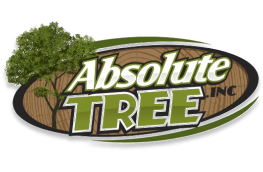
Author Profile: Ashley Davis
Over the last 19 years, Absolute Tree has grown a reputation as one of the premier tree service companies in the Northern Virginia areas. And there’s a good reason for this—we love trees and our passion for them shows. When you call on Absolute Tree for tree service, you aren’t just getting “some guys who cut down trees.” You’re hiring highly skilled arborists who understand the growth of trees and consider tree care an art form.
Stay Up-to-date!
Swing in each month for new articles, pest alerts, local resources, tree care tips, tree health updates, and landscape maintenance ideas
